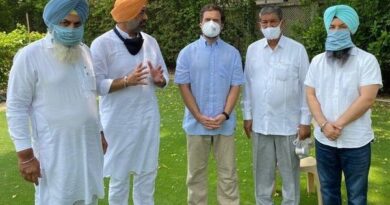Remembering Shaheed Diwas: Bhagat Singh, Sukhdev, And Rajguru’s Sacrifice
Remembering Shaheed Diwas: Bhagat Singh, Sukhdev, and Rajguru’s Sacrifice.
Remembering Shaheed Diwas: Honor the legacy of Bhagat Singh, Sukhdev, and Rajguru on Shaheed Diwas.
Learn about their fearless fight against British oppression, their martyrdom, and the historic events of 23rd March.
The British were afraid of Bhagat Singh, Sukhdev, and Rajguru, all three were hanged laughing; The biggest incident in history happened on 23 March.
The sacrifices of Bhagat Singh, Sukhdev, and Rajguru while fighting the British can never be forgotten. Today, 92 years of sacrifice of these three fighters have been completed.
According to the court order, all three were to be hanged on March 24, 1931, at eight in the morning, but on March 23, 1931, all three were hanged at around seven in the evening.
“On this very day, on 23 March 1931, this big event of history is celebrated as “Martyrs’ Day”.
Bhagat Singh often wrote letters from jail and his last letter written from jail was addressed to his comrades, which was written in Urdu.
The Hindi translation of the letter is taken from Chaman Lal’s book ‘The Bhagat Singh Reader’.
In which he wrote that,”Friends, it is natural that I should also have the desire to live. I don’t want to hide it, but I can survive on one condition that I am not imprisoned or restricted.”
The ideals of the revolutionary parties have raised me very high, so high that I could not have been higher if I had survived.
In the event of me being hanged smilingly, the mothers of the country will expect their children to be Bhagat Singh.
With this, the number of people making sacrifices for freedom will increase so much that it will become impossible to stop the revolution.
The situation changed rapidly after the death of Lala Lajpat Rai.
“Simon Commission” reached Mumbai in February 1927 to investigate the governance reform acts implemented since 1919. There was opposition to the Simon Commission in the entire country.
A procession led by Lala Lajpat Rai was carrying out a peaceful protest against the commission, in which the crowd was increasing.
Seeing such a huge crowd and their protest, Assistant Superintendent Saunders lathi-charged the protesters.
Lala Lajpat Rai was badly injured in this lathi charge, due to which Lalaji died on 17 November 1928.
Since Lala Lajpat Rai was one of Bhagat Singh’s ideal men, he decided to avenge his death.
To avenge the murder of Lala Lajpat Rai, ‘The Hindustan Socialist Republican Association’ gave this task to Bhagat Singh, Rajguru, Sukhdev, Chandrashekhar Azad, and Jaigopal.
As per the planned plan, Bhagat Singh and Rajguru started walking in front of Lahore Kotwali in a busy mood. On the other hand, Jaigopal sat down on his bicycle as if it had broken down.
On Jaigopal’s signal, both became alert. On the other hand, Chandrashekhar Azad was hiding near the boundary wall of the nearby DAV School and working as a guard to carry out the incident.
Remembering Shaheed Diwas: Saunders’s murder gave recognition of revolutionaries to Bhagat Singh, Rajguru, and Sukhdev.
On December 17, 1928, at around 4.15 am, as soon as ASP Saunders arrived, Rajguru shot him directly in the head, after which he lost consciousness.
After this, Bhagat Singh made complete arrangements for his death by firing three bullets. As soon as both of them started running away, a constable Chanan Singh started chasing them.
Chandrashekhar Azad warned him and said – If he moves forward, I will shoot him. When he did not agree, Azad shot him.
The revolutionaries avenged Lalaji’s death by killing Sanders. Saunders’s murder gave Bhagat Singh, Rajguru, and Sukhdev the recognition of revolutionaries in the entire country.
After this incident, the British government was completely distraught. The situation became such that even after being a Sikh, Bhagat Singh had to cut his hair and beard.
In 1929, he actively participated in the massive strike by political prisoners to protest against the inhuman treatment of prisoners in jail.
In those days, the British government prepared to bring the Public Safety Bill and Trade Disputes Bill to the Delhi Assembly. These were very repressive laws and the government had decided to pass them.
The objective of the rulers behind making this bill a law was to nip the seeds of revolution growing among the people before they could germinate.
When Bhagat Singh threw the bomb.
But Chandrashekhar Azad and his colleagues did not accept this at all. He decided that he would create a blast in the Parliament in protest against this so that the deaf British government could hear his voice.
Batukeshwar Dutt was entrusted with this work along with Bhagat Singh. On April 8, 1929, as soon as the bill was announced, Bhagat Singh threw the bomb.
Bhagat Singh raised slogans like Inquilab Zindabad, destruction of imperialism, and also threw several pamphlets in which the anger of the common people against British imperialism was expressed.
After this, there was a period of arresting the revolutionaries. Bhagat Singh and Batukeshwar Dutt got life imprisonment.
Bhagat Singh, Sukhdev, Rajguru got a death sentence.
Rajguru was arrested from Pune and Sukhdev from Lahore. The case of ‘Lahore Conspiracy’ against Bhagat Singh and his companions also continued while they were in jail.
The court proved the revolutionaries guilty and gave its verdict on 7 October 1930, in which Bhagat Singh, Sukhdev, and Rajguru were given the death penalty.




